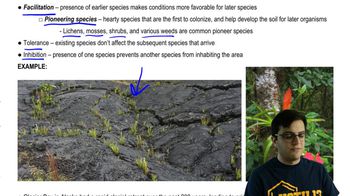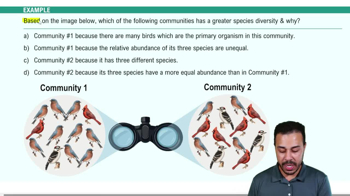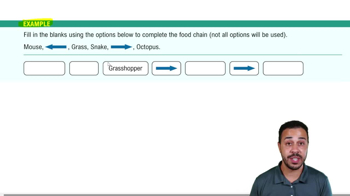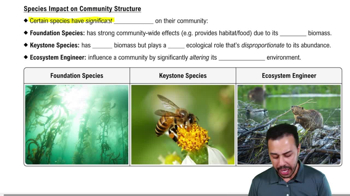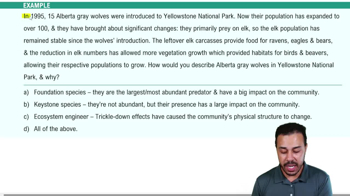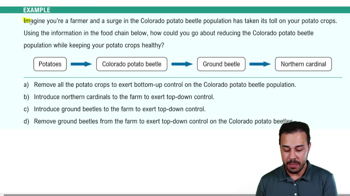Table of contents
- 1. Introduction to Biology2h 42m
- 2. Chemistry3h 40m
- 3. Water1h 26m
- 4. Biomolecules2h 23m
- 5. Cell Components2h 26m
- 6. The Membrane2h 31m
- 7. Energy and Metabolism2h 0m
- 8. Respiration2h 40m
- 9. Photosynthesis2h 49m
- 10. Cell Signaling59m
- 11. Cell Division2h 47m
- 12. Meiosis2h 0m
- 13. Mendelian Genetics4h 44m
- Introduction to Mendel's Experiments7m
- Genotype vs. Phenotype17m
- Punnett Squares13m
- Mendel's Experiments26m
- Mendel's Laws18m
- Monohybrid Crosses19m
- Test Crosses14m
- Dihybrid Crosses20m
- Punnett Square Probability26m
- Incomplete Dominance vs. Codominance20m
- Epistasis7m
- Non-Mendelian Genetics12m
- Pedigrees6m
- Autosomal Inheritance21m
- Sex-Linked Inheritance43m
- X-Inactivation9m
- 14. DNA Synthesis2h 27m
- 15. Gene Expression3h 20m
- 16. Regulation of Expression3h 31m
- Introduction to Regulation of Gene Expression13m
- Prokaryotic Gene Regulation via Operons27m
- The Lac Operon21m
- Glucose's Impact on Lac Operon25m
- The Trp Operon20m
- Review of the Lac Operon & Trp Operon11m
- Introduction to Eukaryotic Gene Regulation9m
- Eukaryotic Chromatin Modifications16m
- Eukaryotic Transcriptional Control22m
- Eukaryotic Post-Transcriptional Regulation28m
- Eukaryotic Post-Translational Regulation13m
- 17. Viruses37m
- 18. Biotechnology2h 58m
- 19. Genomics17m
- 20. Development1h 5m
- 21. Evolution3h 1m
- 22. Evolution of Populations3h 52m
- 23. Speciation1h 37m
- 24. History of Life on Earth2h 6m
- 25. Phylogeny2h 31m
- 26. Prokaryotes4h 59m
- 27. Protists1h 12m
- 28. Plants1h 22m
- 29. Fungi36m
- 30. Overview of Animals34m
- 31. Invertebrates1h 2m
- 32. Vertebrates50m
- 33. Plant Anatomy1h 3m
- 34. Vascular Plant Transport1h 2m
- 35. Soil37m
- 36. Plant Reproduction47m
- 37. Plant Sensation and Response1h 9m
- 38. Animal Form and Function1h 19m
- 39. Digestive System1h 10m
- 40. Circulatory System1h 57m
- 41. Immune System1h 12m
- 42. Osmoregulation and Excretion50m
- 43. Endocrine System1h 4m
- 44. Animal Reproduction1h 2m
- 45. Nervous System1h 55m
- 46. Sensory Systems46m
- 47. Muscle Systems23m
- 48. Ecology3h 11m
- Introduction to Ecology20m
- Biogeography14m
- Earth's Climate Patterns50m
- Introduction to Terrestrial Biomes10m
- Terrestrial Biomes: Near Equator13m
- Terrestrial Biomes: Temperate Regions10m
- Terrestrial Biomes: Northern Regions15m
- Introduction to Aquatic Biomes27m
- Freshwater Aquatic Biomes14m
- Marine Aquatic Biomes13m
- 49. Animal Behavior28m
- 50. Population Ecology3h 41m
- Introduction to Population Ecology28m
- Population Sampling Methods23m
- Life History12m
- Population Demography17m
- Factors Limiting Population Growth14m
- Introduction to Population Growth Models22m
- Linear Population Growth6m
- Exponential Population Growth29m
- Logistic Population Growth32m
- r/K Selection10m
- The Human Population22m
- 51. Community Ecology2h 46m
- Introduction to Community Ecology2m
- Introduction to Community Interactions9m
- Community Interactions: Competition (-/-)38m
- Community Interactions: Exploitation (+/-)23m
- Community Interactions: Mutualism (+/+) & Commensalism (+/0)9m
- Community Structure35m
- Community Dynamics26m
- Geographic Impact on Communities21m
- 52. Ecosystems2h 36m
- 53. Conservation Biology24m
51. Community Ecology
Community Structure
Problem 8`
Textbook Question
Draw a vertical food chain (part of a food web) showing that sea urchins eat kelp and that sea otters eat sea urchins.
Use this model to (1) show or explain how a trophic cascade works; and (2) offer an explanation for why otters are considered a keystone species.
 Verified step by step guidance
Verified step by step guidance1
Start by drawing a vertical food chain with kelp at the bottom, followed by sea urchins, and then sea otters at the top. This represents the flow of energy from producers to consumers.
Explain the concept of a trophic cascade: When sea otters are present, they eat sea urchins, which reduces the sea urchin population. This allows kelp forests to thrive because there are fewer sea urchins to eat the kelp.
Discuss the impact of removing sea otters: Without sea otters, sea urchin populations can increase unchecked, leading to overgrazing of kelp forests and a decline in kelp abundance.
Define a keystone species: A keystone species is one that has a disproportionately large impact on its environment relative to its abundance. Sea otters are considered a keystone species because their presence or absence dramatically affects the structure of the ecosystem.
Illustrate the importance of sea otters: By controlling sea urchin populations, sea otters help maintain the balance of the ecosystem, supporting biodiversity and the health of kelp forests, which serve as habitats for many marine organisms.
 Verified video answer for a similar problem:
Verified video answer for a similar problem:This video solution was recommended by our tutors as helpful for the problem above
Video duration:
3mPlay a video:
Was this helpful?
Key Concepts
Here are the essential concepts you must grasp in order to answer the question correctly.
Trophic Cascade
A trophic cascade is an ecological phenomenon triggered by the addition or removal of top predators, leading to cascading effects on lower trophic levels. In the given food chain, the presence of sea otters, which prey on sea urchins, helps control the sea urchin population. This, in turn, allows kelp forests to thrive, demonstrating how changes at the top of the food chain can significantly impact the entire ecosystem.
Recommended video:
Guided course

Phosphorylation Cascades
Keystone Species
A keystone species is one that has a disproportionately large impact on its environment relative to its abundance. Sea otters are considered a keystone species because their predation on sea urchins prevents overgrazing of kelp forests. Without otters, sea urchin populations would explode, leading to the destruction of kelp habitats and a loss of biodiversity, highlighting the critical role otters play in maintaining ecological balance.
Recommended video:

Biological Species Concept
Food Chain and Food Web
A food chain is a linear sequence of organisms where each is eaten by the next member in the chain. In contrast, a food web is a complex network of interconnected food chains. The image illustrates a food web, showing multiple predator-prey relationships, such as owls preying on rats and foxes preying on beetles. Understanding these interactions helps explain the dynamics of energy flow and nutrient cycling within an ecosystem.
Recommended video:
Guided course
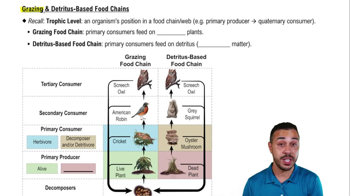
Grazing & Detritus-Based Food Chains
Related Videos
Related Practice








